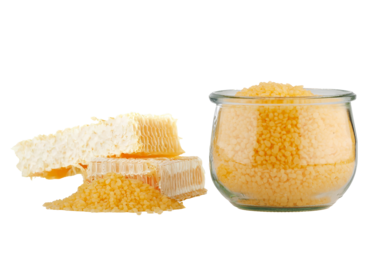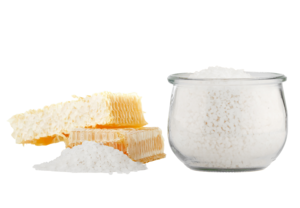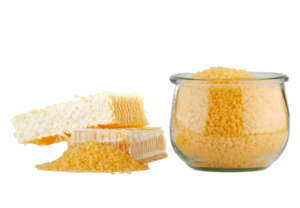Our Beeswax qualities
We carry Beeswax in the following qualities for you
Usage
|
Cosmetics |
Food |
Pharmaceutics |
|
|---|---|---|---|
| Beeswax white cosmetical grade | |||
| Beeswax yellow cosmetical grade | |||
| Beeswax white Ph. Eur. | |||
| Beeswax yellow Ph. Eur. | |||
| Beeswax white Food Grade | |||
| Beeswax yellow Food Grade | |||
| Organic beeswax yellow |
Beeswax is used in the cosmetic and pharmaceutical industries as well as in dental technology to produce dental impressions, polishes in cleaning agents, tree waxes or artists' paints. Beeswax is also used for the production of candles. The benefit of beeswax compared to paraffin or stearin is the longer burning time.

The beeswax
Beeswax is produced by honey bees to be used in the construction of their combs. It consists of 70 to 75% of a mixture of cerotinic and melissic acids, about 70 esters of C16 to C36 acids, and mixtures of C24 to C36 alcohols. A further 5 to 15.5% are carbohydrates, and the remaining components are minerals, colorants, aromatic substances and vitamin A.
Would you like to be informed about the general market situation of Beeswax and our other products?
subscribe to market reportOrigin
Beeswax is produced by the so-called "building bees". These have a total of eight glands on their abdomen from which they squeeze the wax out in the shape of tiny, brittle platelets. In the next step, the bees use their mouthparts to build the honeycombs, which serve as honey storage and breeding grounds. The beeswax freshly squeezed out of the glands is colourless. As soon as the honeycombs are used, they turn dark. To enable bees to produce wax at all, they have to consume a lot of nutrients. It is estimated that bees consume between 4 and 10 kg of honey to produce one kilo of beeswax. Depending on the origin of the beeswax, it contains about 300 different substances. Over time, beekeepers remove the older, darker combs to prevent disease. The beeswax is then extracted from these combs.

Background / history
The honey produced by bees and beeswax have been used for thousands of years by people of different cultures as food or as a high-quality raw material for ointments and cosmetics. In antiquity, writing boards made of wax were used. Wax figures and masks were found as grave goods. The Greek physician Calenus (129-199 AD) , among other things, worked molten beeswax into creams. The London Pharmacopeia of 1618 also described the use of beeswax in an ointment, today known as cold cream. In ancient times, people used to plug holes in their teeth with beeswax.
20
kg
Bag
General durability: 24 months
You want to buy Beeswax?
Request now free of charge and without obligation from Gustav Heess. We deliver Beeswax ...
- worldwide
- fast
- reliable
We offer Beeswax in the following packaging units:
-
20
kg
Bag

